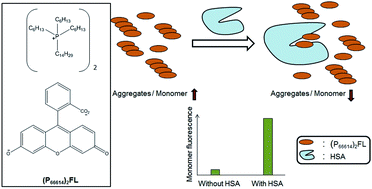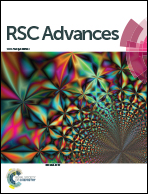Fluorescein-based ionic liquid sensor for label-free detection of serum albumins†
Abstract
Herein, we report a fluorescein-based room temperature ionic liquid (RTIL) as a fluorescent probe for highly selective and sensitive detection of albumins. This RTIL was prepared by pairing dianionic fluorescein (FL) with trihexyl(tetradecyl)phosphonium (P66614) cation. The ionic liquid was then dispersed in aqueous medium to produce nanodroplet dispersions. Examination of fluorescence and UV-vis spectroscopic data suggests that these dispersions are comprised of strongly fluorescent monomeric species and weakly fluorescent J-type aggregates. The relative abundance of these two types of species is observed to be dependent on the type and concentration of proteins. In the presence of bovine serum albumin (BSA) or human serum albumin (HSA), monomeric species are found to be predominant, and hence an increase in fluorescence intensity was observed with increasing concentrations of BSA or HSA. Excellent correlation between fluorescence intensity and HSA concentration was observed, and concentrations as low as 300 ng per mL of HSA were detectable. Overall, these [P66614]2[FL] nanodroplets appear to be very promising materials for facile, inexpensive, rapid, and label-free detection of albumins in aqueous medium with a high degree of accuracy, sensitivity, and selectivity.


 Please wait while we load your content...
Please wait while we load your content...